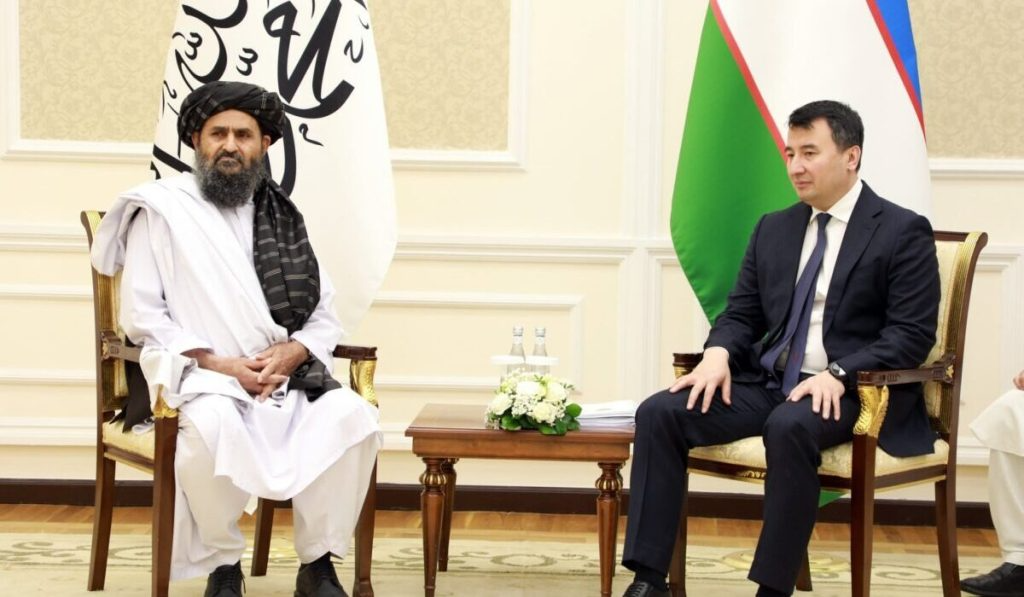Why Uzbekistan Engaging with Taliban?
DIDPress: National Interest reported that Uzbekistan aims to transform Afghanistan from a security threat into a “land bridge” connecting Central Asia to South Asia.

High-Level Meeting Highlights Tashkent’s Commitment
On June 11, 2025, Uzbek President Shavkat Mirziyoyev met with Afghanistan’s acting Minister of Industry and Commerce, Nooruddin Azizi, on the sidelines of the Tashkent International Investment Forum. This meeting underscored Tashkent’s sustained commitment to strengthening trade and infrastructure ties with Afghanistan, despite global reluctance to engage with the Taliban caretaker government.
Uzbekistan’s Goal: Turning Afghanistan from a security threat into a “land bridge” linking Central and South Asia.
Tashkent’s Pragmatic Shift
Since the Taliban’s takeover in 2021, Afghanistan has achieved relative stability, with the group now controlling nearly all provinces. Despite major humanitarian, security, and environmental challenges, Uzbekistan has adopted a pragmatic policy combining dialogue, humanitarian aid, and economic development.
- Humanitarian Assistance: Uzbekistan has sent humanitarian aid to Afghanistan 10 times since 2021.
Airitom Free Economic Zone: A Gateway for Trade
In 2024, Uzbekistan launched the Airitom Free Economic Zone in Termez, near the Afghanitan border. The zone includes:
– Customs terminal
– Logistics infrastructure
– Bank, hotel, hospital, and educational centers
– Annual capacity: 900,000 tons of cargo and 1.5 million visitors
– Target: $1.2 billion in trade turnover
Surge in Bilateral Trade
- 2023: $866 million in trade
- 2024: Increased to $1.1 billion (mostly Uzbek exports)
- Future Target: $3 billion
- 550 Afghan-owned companies operate in Uzbekistan (443 fully Afghanistan-owned).
Key Regional Projects
- Uzbekistan-Afghanistan-Pakistan Railway (Trans-Afghan Corridor)
✔️ 30-40% lower transport costs to Indian Ocean ports
✔️ Projected capacity:- By 2030: 22 million tons
- By 2040: 34 million tons (20% passing through Afghanistan)
- Surkhan-Pul-e-Khumri Power Line
✔️ 1,000 MW capacity
✔️ Goal: Connect Afghanistan’s grid to Central Asia
✔️ Benefit: Lower transport costs via electrification of the Hairatan-Mazar-e-Sharif railway
Human Capital Investment & Education
Since 2018, the Educational Center for Afghanistan Citizens (ECTAC) in Termez has trained 700+ Afghanistani students (including 200 women) in:
- IT, marketing, agriculture, tourism, and tailoring
- Supported by the EU and UNDP, expanding until 2025
- Future Proposal: A “Return and Reintegration Center” in Termez for Afghan migrants returning from Western countries.
Challenges & Conditions for Success
Risks: Instability, terrorism, poverty, rising drug production
Success Depends On:
- Internal stability in Afghanistan
- Taliban’s cooperation with neighbors
- Return and participation of Afghanistan elites & professionals
Conclusion: Uzbekistan’s Unique Model
While most countries avoid engaging with the Taliban, Uzbekistan has adopted a different approach—prioritizing economic pragmatism, humanitarian diplomacy, and regional connectivity.
The future of this model hinges on:
✔️ The Taliban’s ability to ensure stability
✔️ Regional willingness to engage in dialogue and cooperation